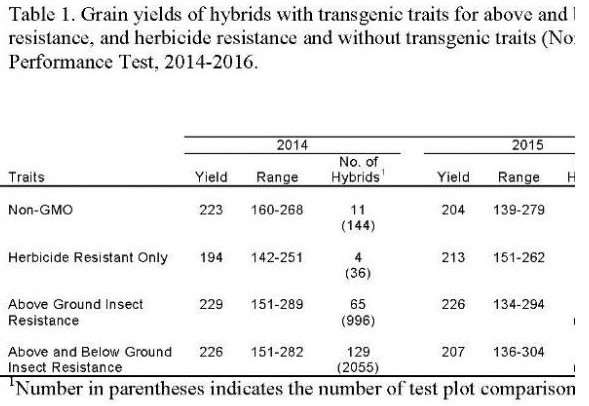By Allen Geyer, Rich Minyo, Peter Thomison
According to the USDA-Economic Research Service in 2016, 86% of Ohio’s corn acreage was planted to transgenic corn hybrids with 66% of total acreage planted to stacked trait hybrids (
https://www.ers.usda.gov/data-products/adoption-of-genetically-engineere...). Some corn growers want to grow non-GMO corn or transgenic hybrids with fewer traits to reduce seed costs. Others want to take advantage of the premiums offered for non-GMO corn. Growers who have not experienced serious problems with rootworm and corn borer and who have controlled weeds effectively with traditional herbicide programs question the need for transgenic hybrids. A major question of growers is whether the yield potential of hybrids with fewer transgenic traits or no transgenic traits is less than that of stacked trait hybrids with multiple genes for above and below ground insect resistance. What do results of the Ohio Corn Performance Tests (OCPT) indicate concerning the relative performance of hybrids with and without various above and below ground insect resistance traits in recent years?

Table 1 shows four groupings of hybrids that were entered in the 2014, 2015 and 2016 OCPT - 1) hybrids without transgenic traits (non-GMO), 2) hybrids with transgenic herbicide resistance, 3) hybrids with transgenic traits for above ground insect resistance, and 4) hybrids with transgenic traits for above and below ground insect resistance (the latter two groups are also characterized by transgenic herbicide resistance). Table 1 also includes the average yield, range in yield, number of hybrids, and number of test plot comparisons associated with each of these groups. Hybrids with transgenic traits comprised over 90% of the OCPT each year. The grouping of hybrids with above and below ground insect resistance accounted for the largest number of hybrids tested in 2014 and 2015. However, in 2016 the grouping of hybrids with transgenic traits for above ground insect resistance only accounted for the largest number of hybrids tested (53%). The number of non-transgenic hybrids and hybrids with herbicide resistance was negligible - accounting for less than 10% of OCPT entries in each of these years.
In Table 1, the average yields and range in yield of the four hybrid groupings show that non-transgenic hybrids are available that yield competitively with many transgenic corn hybrids in the absence of corn borer and rootworm pressure. Similarly yields of hybrids with transgenic traits for above ground insect resistance only were comparable to yields of hybrids with transgenic traits for above and below ground insect resistance. Force 3G soil insecticide is applied in a T-band to all OCPT plots to minimize rootworm injury.
Growers interested in identifying high yielding hybrids with varying numbers of transgenic traits should consider using the Ohio Corn Performance Test website http://oardc.osu.edu/corntrials/. Once a region or test location is selected, the sort feature under “Traits” can be used to assess the performance of hybrids with varying transgenic traits and without transgenic traits (non-GMO).